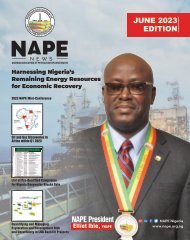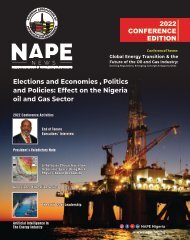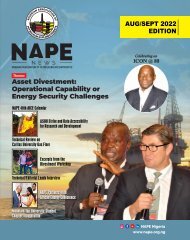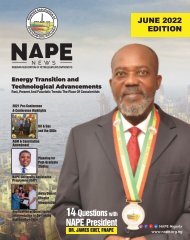Create successful ePaper yourself
Turn your PDF publications into a flip-book with our unique Google optimized e-Paper software.
CHAPTER TECHNICAL SESSIONS<br />
AKWA/OWERRI<br />
CHAPTER<br />
The magnitude, severity and scale of environmental<br />
impacts correspond to the type and nature of<br />
stressor components. Changes in energy policies,<br />
demands and exploration are accompanied by<br />
significant environmental impacts that appear to<br />
alter the life cycle of people resident at or near<br />
specified ground zeros.<br />
Oil spill, for instance, has profoundly decimated<br />
lands, water and resources, destroyed lives and<br />
dreams, and derided creation and creativity. Unaware of well-defined<br />
environmental signatures that mirror corresponding energy attitudes, stakeholders<br />
and scientists have over the years lumped semi-classified impacts into a redundant<br />
domain in the cause and effect hypothesis.<br />
This lecture unbundles thelump, identifies clear-cut indicative footprints and aligns<br />
them with varying energy regimes within a bounded territory. It is theorized that the<br />
recognition of the signatures associated with contrasting energy schemes will aid<br />
the cleaner prediction and mitigation of potential future impacts.<br />
This novel model, in addition to securing lives and resources, will alsopropel the<br />
development of our world in a smart and sustainable pattern.<br />
On account of the relative ease of access to geological<br />
exposures on the Earth surface, the critical elements<br />
of a hydrocarbon system such as trap, source,<br />
reservoir and seal rocks, commonly complete in the<br />
subsurface, can be simulated on outcrop, even if as<br />
discrete components. Sedimentological field studies<br />
yield sets of data onstratigraphic sections and bed<br />
geometries, macroscopic textures, fabrics, mineral<br />
constituents, sedimentary structures, and tectonic<br />
configurations from which features the depositional<br />
environments can be diagnosed and the paleogeographic models formulated. In<br />
particular, reservoir attributes documented in the field and supplemented with<br />
laboratory analytical data, enable conceptualisation of the fluid dynamics within this<br />
highly compartmentalized containment component of the trapping configuration.<br />
The recognition of the equivalencies between the outcropping elements and their<br />
subsurface counterparts facilitate insight into the upstream (exploration and<br />
production) aspects of the petroleum industry through field and laboratory studies<br />
carried out at a minimum cost in a non-industrial setting, but of great help in<br />
assessing the technical risks and improving the accuracy of subsurface<br />
interpretations. This approach is recommended for exploring the Nigerian inland<br />
basins where outcropping lithologies and tectonic structures should constitute<br />
pointers to prospective hydrocarbon plays in the presently inaccessible subsurface.<br />
Upcoming Session<br />
but limited resources.<br />
BENIN CHAPTER<br />
Every discipline has been impacted over the years by<br />
technological advancements and geoscience is not an<br />
exception. New blue-chip startups emerge almost daily –<br />
disrupting existing norms and initialing others. Business<br />
owners have to adapt to new visions or align with<br />
technology trends to remain afloat. The difference between<br />
success and failure now has more to do with the extent to<br />
which business executives exhibit technological insight and<br />
foresight. E&P organizations therefore continue to hustle<br />
and juggle in the highly dynamic market space not just to<br />
avoid going sublime but to maximize revenue and optimize<br />
their use of limited resources to efficiently exploit available<br />
All these therefore come with new demands on the workforce. In this side of the world, a good<br />
grade out of high school is no longer enough. Employers demand resources who can add value<br />
from day one. There is the “added advantage syndrome”in the labour market and those who are<br />
able to prove that they have been in vectorial concordance with digital transformational trends<br />
tend to be the ones that ride these waves successfully and many grow to be captains of<br />
organizations and industries.<br />
As E&P organizations are looking for how to get affordable, reliable, sustainable energy; and<br />
how to do so efficiently; as considerations for carbon capture and green energy are on the rise,<br />
the focus turns to the geoscientist to provide for these global needs.<br />
The geoscientist must therefore be prepared to face the challenges ahead. This presentation<br />
exudes the salient demands and knowledge domains digital transformation has introduced and<br />
profferssolutions on how the geoscientist may be better prepared to meet the current demands<br />
and the challenges ahead. Participants will learn from assorted examples on the application of<br />
trending technologies: artificial intelligence, machine learning, and data analytics in the<br />
geoscience domain. They will be informed on basic skills required to move with technological<br />
trends and be the geoscientist who are sought after in this digital age.<br />
Approximately 31% non-productive time while drilling for oil<br />
and gas in non-salt well have been attributed to geomechanics<br />
(Dodson et al. 2009).Drilling campaign in Niger Delta has been<br />
characterized by instability challenges such as differential<br />
sticking/stuck pipe, hole-collapse/pack-off, lost circulation,<br />
well ballooning, kicks, etc.<br />
According to James Dodson survey in 2007, the oil and gas<br />
industry loses approximately 8 billion US dollar on yearly to<br />
problems associated with wellbore instability. Drilling process<br />
involves the removal of rock materials that once supported the<br />
insitu stress along the borehole trajectory, leaving the rock surrounding the hole to take the load<br />
previously taken by the removed rock. This causes concentration of stresses around the<br />
wellbore and often exceed the rock strength, therefore requires enough drilling fluid support to<br />
avoid wellbore stability issues. Understanding of the magnitude of hoop stress along the<br />
wellbore is critical for selecting the optimum mud weight requires to drill successfully without<br />
instability.<br />
Addressing this instability challenge requires detailed wellbore stability analysis of various<br />
analogue wells, identifying why the well failed and incorporating learnings from them into<br />
actionable plans for new drilling campaigns.<br />
Since the discovery of oil by Shell BP at Oloibiri Nigeria in<br />
1956, after half a century of exploration activities, there has<br />
been recorded increase in oil and gas infrastructure attacks<br />
and oil-related criminal violence. All these are classified as<br />
outdoor crimes with its attendant exposures and have<br />
increased the flow of illegal crude, as such affected the<br />
flagging oil production in the country. The perceived rise in the<br />
dynamics of organized crime and environmental damage in<br />
the context of Nigeria's oil industry vis-a-vis the noticed<br />
persistent lack of security of oil and gas assets triggered this<br />
research. The exercise involves timely and adequately<br />
securing the oil and gas-related crime scene, collection of general data (date, time and place),<br />
geographic data (longitude, latitude, elevation, solar orientation) as well as collection of relevant<br />
prints and spills cum pedological and ancillary data. These datasets serve as input parameters<br />
into the proposed 'ibeneguzo' software package. The result would, among other things, present<br />
an approximate guide to identifying the person(s) around the crime scene as at crime time and<br />
by extension the perpetrators of such act. This software will serve as an extension and plug-in<br />
cum add-on to the SCADA system in use which would help in providing information for<br />
presentation of expert witness during trials. This will go a long way in vindicating the innocent<br />
and assisting the jury in delivering effective justice.<br />
NAPENEWS AUG/SEPT <strong>2022</strong> 58










